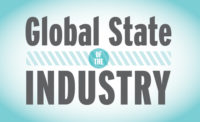It takes more than a few whacks to bring down a piñata. Believe me, I know. I’ve thrown a few parties where children and adults have swung at a paper-mache donkey to get at candies. Blindfold aside, it’s especially difficult when there’s someone on a balcony pulling that darn animal up and down, to and fro.
And in reviewing data and statistics from Euromonitor International, Mintel and IRI, one can easily get confused and dizzy, quickly becoming disoriented at where to strike. At first glance, all is good with the confectionery world. Euromonitor estimates that the chocolate, sugar and gum categories all grew, delivering a 4.1 percent gain in 2016 for the global confectionery industry. Total sales grew from $168.75 billion to $176.72 billion.
Chocolate, no surprise, led all segments with a 4.8 percent jump in revenues while sugar — thanks to the chewy candies category — posted a very respectable 3.6 percent gain. Even gum, for that matter, masticated its way out of the doldrums and registered a 2.3 percent gain. Not quite the “double your pleasure” standards of the past, but a courageous step forward toward respectability again.
In lifting the blindfold slightly and casting an eye on regional growth, it’s the Middle East that stands out as a sweets paradise. Confectionery sales rose 9.3 percent last year. Granted, it still ranks next to last with regards to volume, but this region’s penchant for sweets, coupled with a demographic skewed toward youth, is generating interest and investment.
Imagine the numbers if there were no “hot spots” in the area, where war and ethnic conflict, which remain part of several nations’ daily regime, were exceptions rather than realities.
Eastern Europe and Latin America remain strong confectionery consuming areas, posting 7.8 and 7.1 percent growth rates, respectively. Eastern Europe continues to display its traditional and historical affinity for chocolates and sweets. Even Russia, which saw its economic vitality drained by slumping oil prices and Putin’s imperial policies, shows signs of recovery. Again, confectionery processing and packaging equipment suppliers are confirming a return to normalcy and continued investment.
Latin America, buoyed by the Mexican economy and an overall younger demographic skew, promises to be even a more attractive confectionery region during the coming years, especially if Brazil overcomes its political ineptness and economic doldrums and Venezuela returns to some kind of normalcy.
With regards to the larger markets, both Asia Pacific and North America posted respectable sales gains. Now that the Asia-Pacific sector has become the world’s second largest market for confections, with China leading the way, multinational and regional manufacturers keep a close eye on that region’s appetite for sweets. A slight hiccup in China’s economic well-being last year sent a few shivers across the world, but the sheer numbers and ongoing evolution of chocolate there promises more growth.
North America, while stable, poses several challenges for manufacturers, be they multinational or midsized, global or regional. Take chocolate, for example. Although the region as a whole posted a 3.3 percent gain, recent IRI numbers (see pgs. 19-20) for specific confectionery categories in the United States suggest a dropoff in sales and volume.
But as we all know, sales numbers can fluctuate, particularly when there are seasonal shifts, i.e. an early or late Easter, a late Thanksgiving or even weather anomalies. But other research houses, such as Mintel, corroborate the fact that chocolate sales have slowed in major markets like the United States.
A Financial Times article on the decline of Swiss chocolate sales — and chocolate sales in general — quoted Jean-Phillipe Bertschev, an analyst at Vontobel in Zurich, as saying, “The U.S.-led trend towards healthier snacking, stagnating markets, aggressive pricing by hard discount retailers — all these factors are making life less comfortable [for Swiss chocolate].”
It’s certainly driving anyone competing in the U.S. marketplace out of their “comfort” zone. Still, there’s good news.
The sugar segment has outpaced chocolate growth in North America, registering a 4 percent surge versus a 3.5 percent gain for chocolate. The appeal of chewy candies, particularly in reformulated, “healthier” recipes, has fueled consumption from a broad range of consumers, encompassing young families, Millennials and even Baby Boomers.
And finally, there’s the world’s largest confectionery marketplace, Western Europe. A 2.1 percent sales growth represents some movement. Here, too, the comments made by Bertschev would apply, but even more so.
The extraordinary interest in health and wellness, as witnessed by the strong presence of overall organic sales, has tempered the centuries-old affinity for sweets in Europe. Nonetheless, a 2.6 percent increase in chocolate sales and a 1.7 percent climb in sugar sales still represent a tremendous amount of volume for the world’s “cradle of candy.”
Now that we’ve smashed the piñata and strewn candies every which way, what can we determine from picking up the pieces? Is there any sense to the pattern they made?
Mintel’s Global Annual Review on the confectionery market provides some guidance:
“The major issues in the confectionery categories in 2016 had to do with the blurring lines between confectionery and snacks, as more chocolate and sugar confectionery ingredients find their way into snacks. Other issues revolve around permissibility – and how and when consumers feel that ‘a little something sweet’ is a permissible treat.
“Also changing the face of the confectionery market is the changing ‘real estate’ in channels that sell sweets. As the checkout lanes in supermarkets and other mass channels become off-limits to confectionery, marketers are scrambling to find other locations for their products. One such space is the online channel, which is just starting to be understood for confectionery retailing.”
Add to this what the PMMI’s report on global food industry trends reveals:
- A growing middle class — expected to double by 2030 — with Asia as a significant consumer of value-added nutritional food.
- On-the-go eating has consumers looking for portion control and convenience in bite-sized, flavorful foods.
- Evening and relaxation foods with quick preparation times are growing; however, consumers look for a full-meal experience with weekend cooking.
- Clean labels – 37 percent of U.S. consumers find it important to understand ingredients on food labels. Nine out of 10 (91 percent) believe that products with recognizable ingredients are healthier.
- The rise in organic food demand has fueled more than 10 percent annual growth in organic foods, although organic food sales make up only about 5 percent of the total market.
At the recent interpack show in Dusseldorf, Germany, last month, PMMI President and CEO Charles Yuska told a gathering of journalists at a global packaging trends luncheon that one of the major macroeconomic trends “impacting our industry is the growth of the middle class and a rise in disposable income. In developed regions, increased travel, busy lifestyles and growing health consciousness have increased demand for indulgent yet healthy foods, convenience foods, different portion sizes, different packaging designs and completely new foods.”
“Consumer purchasing preferences are also changing. Online food sales are growing rapidly, a trend reinforced by the growing use of mobile phones and shopping applications,” Yuska added.
“Consumers welcome additional choices and are willing to pay more for products that are locally sourced, produced with quality ingredients and resonate as authentic. This trend toward more customization and increased premiumization, has fueled the need for increasingly flexible equipment that can handle shorter runs and more frequent changeovers.”
So that’s what the global market place is and will evolve to — a compilation of trends within developed and developing markets, intermixed amongst each other.
A look at Mintel’s balloon charts within this article details the anomalies within regions while IRI’s U.S. statistics zero in on category differences within one national market.
For example, Mintel notes that in the United States, United Kingdom, Germany and France, sales were flat over the two-year period (2015-2016), while sales fell in Russia (-2 percent), Brazil (-6 percent), and China (-6 percent). The only markets in the Top Ten to see any growth were Poland (+2 percent) and India, which saw significant growth in the category (+13% between 2015 and 2016).
In the sugar and gum confectionery market, a similar picture emerges for 2016, Mintel says.
“In developed markets, growth has been flat to negative while in emerging markets there has, for the most part, been notable growth. In China, for example, volume sales of sugar and gum confectionery grew 8 percent between 2015 and 2016, while in India, volume sales were up 14 percent and in Mexico, sugar taxes seem not to have impacted the sugar confectionery market, as sales were up 6 percent in the same period.
“But, the story was different in developed markets: in the United Sates, volume sales of sugar and gum confectionery were flat between 2015 and 2016, a situation reflected in volume sales in the UK. And, in Germany and Russia, volume sales declined (down 2 percent in Germany and 4 percent in Russia).
As Mintel notes, “Launch activity in the confectionery categories was somewhat restrained in 2016. Chocolate confectionery launches grew 3 percent between 2015 and 2016, led by seasonal launches, which still retain some allure, but launches in sugar and gum confectionery were flat.
“In chocolate confectionery, interest in ethical products remains relatively strong, with 17 percent of new products claiming some sort of “ethical-human” positioning, which could include Fair Trade, Rainforest Alliance, or some other, independent “bean-to-bar” certification.”
Couple all of this with a changing retail landscape, and the head starts spinning.
As John Stanton, professor of food marketing, St. Joseph’s University, told Western Candy Conferences attendees last year, “If most of your sales have been going through traditional supermarkets you are selling to a declining market.
“Retail is going through an unprecedented period of rapid dynamism — and this is primarily due to a changing shopper,” he said quoting PlanetRetail.
Case in point, supermarkets also have fewer shopping visits, down to 1.2 times a week from as many as three times a week just a few years ago, Stanton noted.
“What does this mean to candy?” he asked those in the audience. “Fewer ‘impulse’ occasions and less time spent shopping.”
Consumers are also turning away from Big Box stores - the core channel for most of the leading food companies, he added, again citing Planet Retail.
So where are all the supermarket shoppers going?
NPD reports that the average number of visits consumers made to a c-store in an average 30-day period grew to 6.4 compared to 1.5 for supermarkets. Ouch.
Or maybe hurrah! It certainly means rethinking the package size, the merchandising, even the product.
Finally, let’s zero in on the U.S. market. In reviewing the IRI chocolate sales chart, it’s clear that easily consumable chocolates, less than 3.5 oz., demonstrated the most appeal, with a 3.2 percent sales gain. Surprisingly, snack sizes didn’t register the same kind of draw. Gift box sales also slumped while novelties certainly need a promotional whack to stir things up.
In reviewing the candy sales segment, it’s no surprise regarding chewy candies, which have been growing for the past several years. What startled even this observer was the rise in mints. No doubt, breath freshening has returned as a priority among Millennials and Generation Y’ers. I’d include Baby Boomers, but I sense they’ve been regular customers.
As for gum, there’s improvement. Still, the category requires an injection of marketing and product development moxie. A bubble bang, so to speak!
Perhaps the most telling overview regarding all these facts and figures is the most recent announcement coming from Washington, D.C. And no, it has nothing to do with President Trump.
Rather, Mars Chocolate, Wrigley, Nestlé USA, Ferrero, Lindt, Ghirardelli, Russell Stover, and Ferrara Candy Co. announced they are redoubling their efforts to create more options in innovative packaging as well as educating consumers about how unique products such as chocolate and candy can play a role in a happy, balanced lifestyle.
The companies, in conjunction with the National Confectioners Association, made the announcement at the Partnership for a Healthier America Building a Healthier Future Summit in Washington. Seems like those scattered candies are spelling out a message: Transparent treats.

























